Gardening in Massachusetts offers unique challenges and rewards due to the state’s diverse climate and soil conditions. From the coastal areas to the inland regions, Massachusetts gardeners can grow a wide variety of plants with the right knowledge and techniques. Whether you are a seasoned gardener or just starting, this guide will help you make the most of your gardening efforts in the Bay State.
1. Understanding Massachusetts’ Climate
Massachusetts has a varied climate, with coastal areas experiencing milder winters and cooler summers compared to the inland regions. The state falls into USDA hardiness zones 5a to 7b, which means gardeners need to be mindful of the frost dates and growing seasons specific to their region.
- Frost Dates: The last frost date in spring and the first frost date in fall vary across the state. Typically, the growing season ranges from late April to October. Knowing these dates helps in planning planting schedules to avoid frost damage.
- Temperature and Precipitation: Summers can be warm and humid, while winters are cold and snowy. Rainfall is fairly evenly distributed throughout the year, but gardeners should be prepared for occasional droughts or heavy rains.
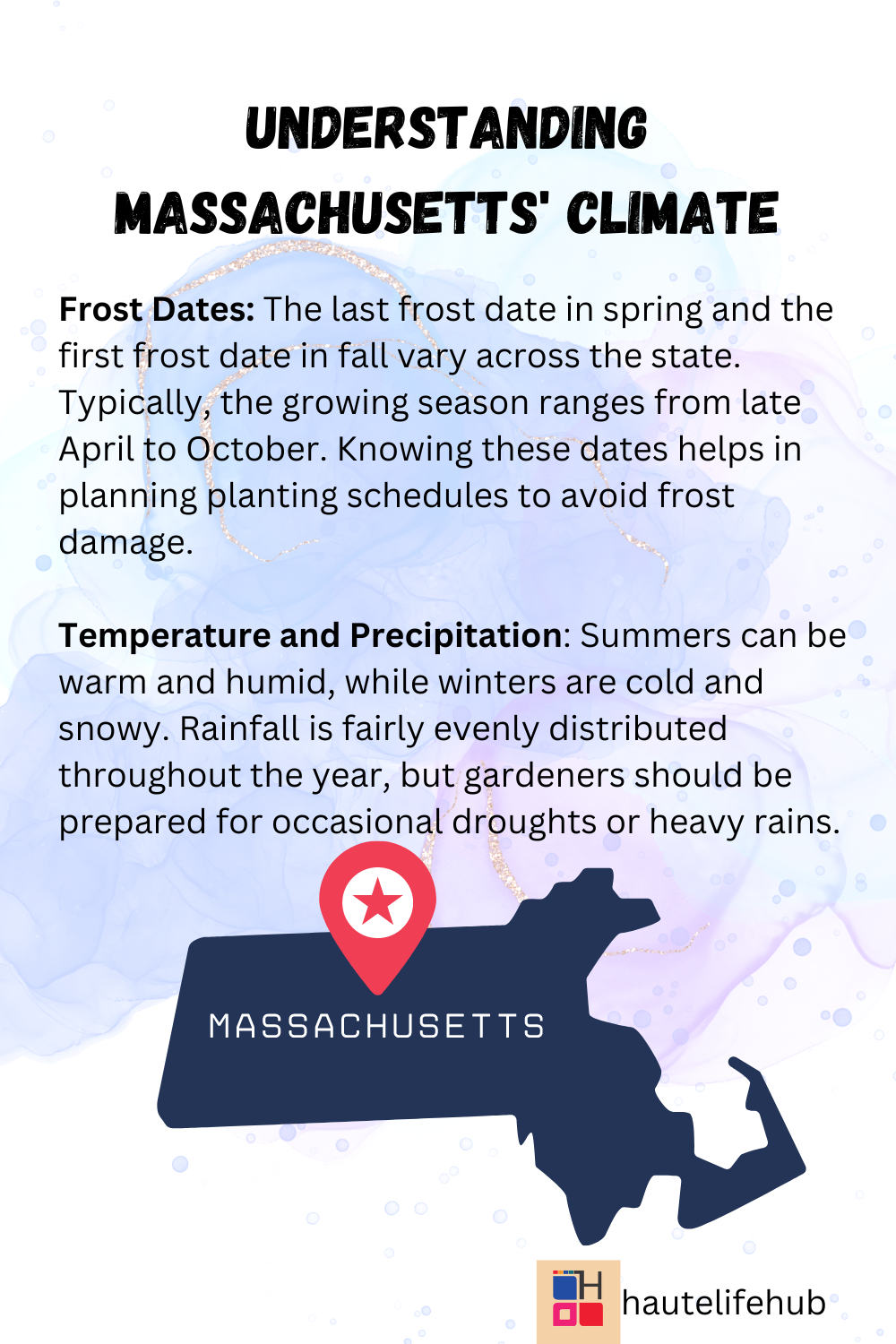
2. Understanding Soil Types in Massachusetts
Massachusetts boasts a variety of soil types due to its diverse geography, ranging from coastal areas to hilly inland regions. Understanding the different soil types in Massachusetts is crucial for gardeners, as it allows them to select the right plants and amendments to ensure a thriving garden. Here, we’ll explore the primary soil types found in the state and offer tips on how to work with each.
Sandy Soils
- Texture: Coarse and gritty, with large particles.
- Drainage: Excellent drainage, but can dry out quickly.
- Nutrient Content: Often low in nutrients due to leaching.
- Common Areas: Coastal regions and sandy plains.
Loamy Soils
- Texture: Balanced mixture of sand, silt, and clay, with a crumbly texture.
- Drainage: Good drainage with adequate moisture retention.
- Nutrient Content: High in nutrients and organic matter.
- Common Areas: Many parts of the state, especially in valleys and lowlands.
Clay Soils
- Texture: Fine particles that stick together, forming clumps.
- Drainage: Poor drainage, leading to waterlogged conditions.
- Nutrient Content: High in nutrients but may be inaccessible to plants due to poor aeration.
- Common Areas: Inland areas and regions with heavy, compacted soil.
Silt Soils
- Texture: Smooth and floury when dry, slippery when wet.
- Drainage: Moderate drainage, retaining more moisture than sandy soils but less than clay soils.
- Nutrient Content: Often fertile but prone to compaction.
- Common Areas: Floodplains and river valleys.
Peaty Soils
- Texture: Dark, spongy, and high in organic matter.
- Drainage: Poor drainage, holding a lot of moisture.
- Nutrient Content: High in organic matter but may be acidic.
- Common Areas: Wetlands and areas with high water tables.
Rocky Soils
- Texture: Mixture of soil and various-sized rocks.
- Drainage: Good drainage, but may have poor water retention.
- Nutrient Content: Can vary widely; often low in organic matter.
- Common Areas: Hilly and mountainous regions.

Soil Preparation
Soil quality can vary widely in Massachusetts, from sandy soils on the coast to clay soils inland. Here are some tips for preparing your soil:
- Soil Testing: Conduct a soil test to determine pH levels and nutrient content. Massachusetts soils tend to be acidic, so you may need to add lime to raise the pH.
- Amendments: Add organic matter such as compost, well-rotted manure, or leaf mold to improve soil structure and fertility. This enhances drainage in clay soils and water retention in sandy soils.
- Mulching: Apply a layer of mulch around plants to conserve moisture, suppress weeds, and regulate soil temperature.
3. Choosing the Right Plants in Massachusetts
Selecting plants suited to Massachusetts’ climate and soil conditions is crucial for a successful garden. Here are some recommended plant choices:
- Vegetables: Cool-season crops like lettuce, spinach, and peas thrive in spring and fall. Warm-season crops such as tomatoes, peppers, and cucumbers do well in the summer. Consider planting hardy varieties that can withstand the local climate.
- Fruits: Strawberries, blueberries, apples, and pears are popular fruits that grow well in Massachusetts. Planting disease-resistant varieties can help ensure a healthy harvest.
- Herbs: Many herbs, including basil, thyme, rosemary, and parsley, flourish in Massachusetts gardens. They can be grown in containers or directly in the ground.
- Flowers: Native flowers like coneflowers, black-eyed Susans, and bee balm are excellent choices for adding color and attracting pollinators. Perennials such as daylilies and hostas also do well in Massachusetts gardens.
- Trees and Shrubs: Planting native trees and shrubs like maples, oaks, rhododendrons, and azaleas can provide structure and beauty to your landscape.

4. Watering Practices for Massachusetts Gardens
Effective watering practices are essential for maintaining a healthy and thriving garden in Massachusetts. The state’s diverse climate, which includes cold winters and humid summers, requires gardeners to adapt their watering strategies throughout the year. Here are some best practices for watering your Massachusetts garden:
Efficient Watering Techniques
- Drip Irrigation: Drip irrigation systems deliver water directly to the plant roots, reducing evaporation and ensuring efficient water use.
- Soaker Hoses: These hoses slowly release water along their length, providing even moisture to the soil and plants.
- Watering Cans: For smaller gardens or container plants, watering cans offer precise control over water distribution.
Timing and Frequency
- Morning Watering: Watering in the early morning allows plants to absorb moisture before the heat of the day, reducing evaporation and minimizing disease risk.
- Deep Watering: Water deeply but infrequently to encourage deep root growth. This helps plants withstand dry periods and reduces the need for frequent watering.
- Adjusting Frequency: Watering frequency should be adjusted based on weather conditions. Increase watering during hot, dry spells and reduce it during cooler, wetter periods.
Mulching
- Mulch Application: Applying mulch around plants helps retain soil moisture, reduce evaporation, and regulate soil temperature.
- Types of Mulch: Organic mulches such as straw, wood chips, or compost are effective options. Ensure a layer of 2-3 inches around plants, avoiding direct contact with stems.
Water Conservation
- Rainwater Harvesting: Collect rainwater in barrels to use for watering your garden. This sustainable practice conserves water and reduces your utility bill.
- Drought-Tolerant Plants: Incorporate drought-tolerant and native plants that require less water and are adapted to local climate conditions.
- Efficient Use: Avoid over-watering by monitoring soil moisture and using efficient watering systems.
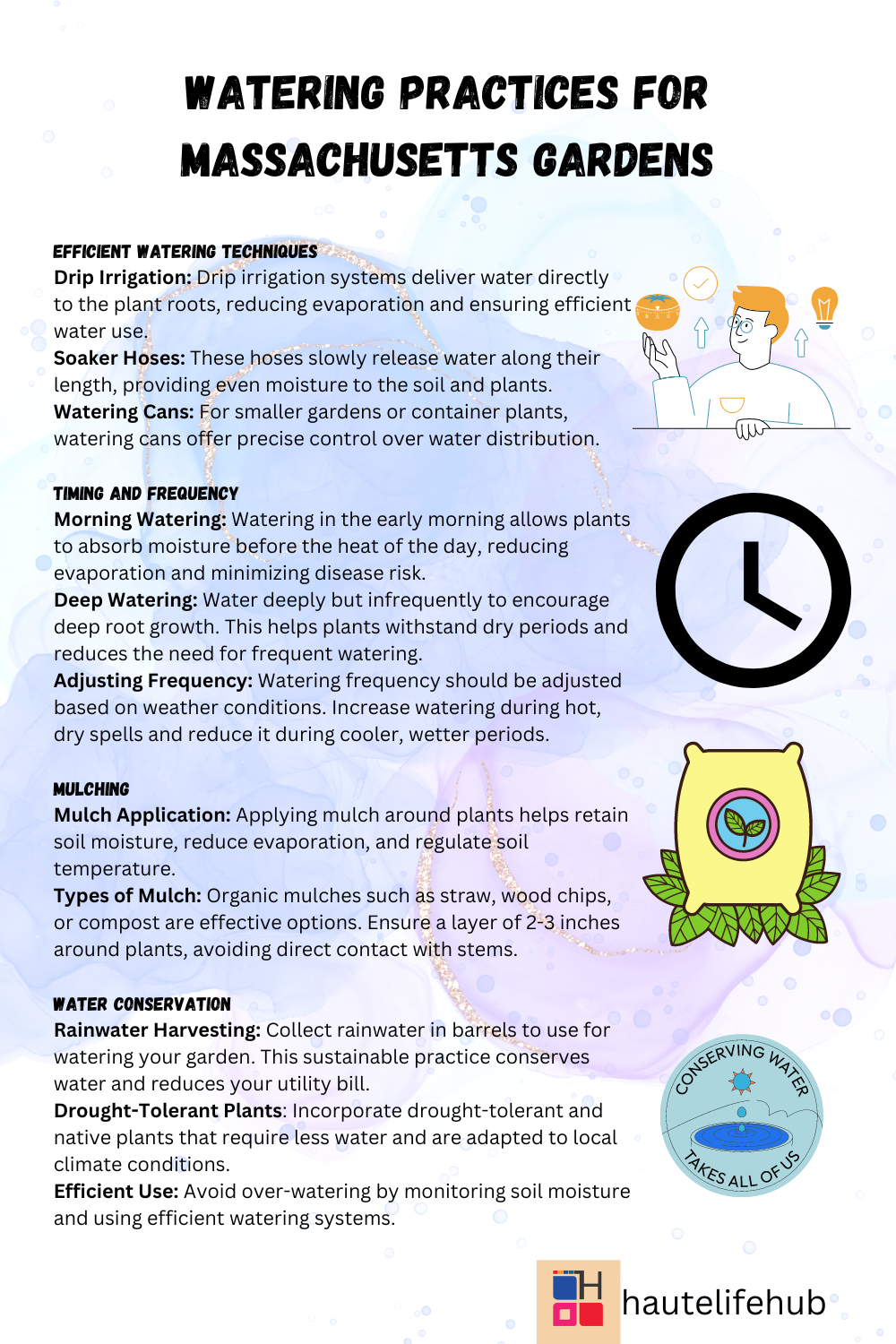
5. Dealing with Pests and Diseases
Gardening in Massachusetts presents unique challenges when it comes to managing pests and diseases. The state’s diverse climate and flora create an environment where various pests and diseases can thrive. Here are some effective strategies for managing these issues and ensuring a healthy garden.
Integrated Pest Management (IPM)
Integrated Pest Management (IPM) is a holistic approach that combines multiple methods to control pests and diseases in an environmentally friendly way. Here’s how to implement IPM in your Massachusetts garden:
Cultural Controls:
- Crop Rotation: Rotate crops annually to disrupt pest and disease cycles. Avoid planting the same family of plants in the same spot each year.
- Proper Spacing: Ensure adequate spacing between plants to improve air circulation and reduce humidity, which can decrease the incidence of fungal diseases.
- Sanitation: Remove and dispose of diseased plant material and fallen leaves to reduce the spread of pathogens.
Biological Controls:
- Beneficial Insects: Introduce beneficial insects like ladybugs, lacewings, and predatory beetles that feed on pests. These natural predators can help keep pest populations in check.
- Companion Planting: Plant flowers and herbs that attract beneficial insects. For example, marigolds can repel nematodes, while dill and fennel attract predatory insects.
Mechanical Controls:
- Physical Barriers: Use row covers, netting, and plant collars to protect plants from pests. These barriers can prevent insects like cabbage moths and root maggots from reaching your crops.
- Handpicking: Manually remove larger pests, such as tomato hornworms and Japanese beetles, from plants. Drop them into a bucket of soapy water to eliminate them.
Regular Monitoring
Regular monitoring is crucial for early detection and management of pests and diseases. Here’s how to stay vigilant:
- Frequent Inspections: Check your plants regularly, at least once a week, for signs of pests and diseases. Look for discolored leaves, holes, wilting, and unusual spots or growths.
- Pest Identification: Learn to identify common garden pests and their life stages. This knowledge will help you take appropriate action quickly.
- Disease Symptoms: Familiarize yourself with the symptoms of common plant diseases, such as powdery mildew, blight, and rust. Early intervention can prevent these diseases from spreading.
Organic Solutions
Organic solutions provide environmentally friendly alternatives to chemical pesticides and fungicides. Here are some effective options:
Neem Oil:
- Neem oil is a natural insecticide and fungicide derived from the neem tree. It is effective against a wide range of pests, including aphids, spider mites, and whiteflies, as well as fungal diseases like powdery mildew.
- Application: Dilute neem oil according to the instructions and spray it on affected plants. Apply in the early morning or late evening to avoid harming beneficial insects.
Insecticidal Soap:
- Insecticidal soap is made from potassium salts of fatty acids and is effective against soft-bodied insects like aphids, mealybugs, and thrips.
- Application: Spray the soap solution directly on pests, ensuring thorough coverage. Reapply as needed, especially after rain.
Copper Fungicides:
- Copper fungicides are effective against a variety of fungal and bacterial diseases, including blight, leaf spot, and downy mildew.
- Application: Apply copper fungicide according to the label instructions, focusing on affected areas and the base of the plants. Use as a preventative measure or at the first sign of disease.
Community Resources for Massachusetts Gardening
UMass Extension
The University of Massachusetts Amherst provides valuable resources, including soil testing, pest management guides, and gardening workshops. Their extensive programs support gardeners with research-based information and practical advice.
Local Nurseries and Garden Centers
These establishments offer region-specific advice and high-quality plants suited to your area. Knowledgeable staff can guide you in selecting the best plants and products for your garden’s needs.
Massachusetts Horticultural Society
This society offers educational programs, gardening classes, and events throughout the year. Members receive access to gardening libraries, special plant sales, and discounted entry to horticultural events.
Massachusetts Master Gardener Association
This organization trains and certifies Master Gardeners who volunteer their time to educate the public about gardening. They offer workshops, lectures, and plant clinics for personalized gardening advice.
Local Extension Offices
In addition to UMass Amherst, local county extension offices provide resources and support. They offer information on local soil conditions, pest problems, and best practices for gardening in your specific area.
Online Forums and Social Media Groups
Numerous online communities and social media groups are dedicated to gardening in Massachusetts. These platforms offer spaces to ask questions, share photos, and get advice from fellow gardeners in your area.
